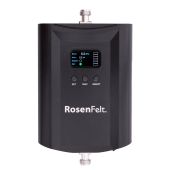
Not onlhy in GSM repeaters, the decibel (dB) is a unit used in acoustics to measure the intensity of sound (named after inventor Alexander Graham Bell).To date, it is widely used in numerous application fields and particularly in telecommunications.
- On the power of GSM repeaters
- How to calculate the power received by each internal antenna of GSM repeaters?
- Notes on GSM repeaters
As far as we are concerned, this unit of measurement can in particular express the power amplification of GSM repeaters, that is, the level of output power relative to input power, the attenuation of a transmission line, anda again the gain of an antenna.
On the operation of antennas my French colleague Vincent has written an excellent article, which I have simply translated into English, trying to keep his style clear and simple. We will write more, of course, given the vastness of this world!
1. On the power of GSM repeaters
Regarding the power of GSM repeaters, let us take as an example a very popular GSM Voice repeater, the RF-E10S. This somewhat robotic name actually contains useful information, a figure that indicates precisely the power of the repeater expressed in dBm (decibels milliwatts). In this case, the power of the repeater is 10 dBm.
Now, according to the bit of experience we have put together over the years, 10dBm GSM repeaters are suitable for covering a single floor of a building (with maximum square footage of 500 sq. m., under optimal conditions, i.e., in an open space with few obstacles such as shelves, walls, etc.). In fact, 10 dBm is sufficient to handle 1 indoor antenna.
What if I have a 2-story house and want to improve the cellular signal in both of them? I will need 2 indoor antennas, consequently we need GSM repeaters that are powerful enough to "hold" such a system. This model RF-ED13-H is perfect for the purpose and we can say that the ideal power for our GSM repeaters with two indoor antennas is just 13 dBm.
2. How to calculate the power received by each internal antenna of GSM repeaters?
There are GSM repeaters in our assortment that go up to 23 dBm and can theoretically handle up to 8 indoor antennas. However, it depends on the conformation of the indoor environment, so it is a good idea to evaluate on a case-by-case basis and especially without haste. However, under optimal conditions we can say that:
- 10 dBm > 1 indoor antenna
- 13 dBm > 2 antennas
- 15 dBm > 3 antennas
- 20 dBm > 4/6 antennas
- 23 dBm > 8 antennas
ourage, we're almost done with the technical stuff for today: let's say a few words about attenuation, which comes into play just as we are envisioning our two-antenna system. To recap, we purchased a custom RF-ED13-H with an extension set with 2 indoor antennas. In the kit we have:
- 13 dBm GSM repeater
- outdoor antenna and cable (we ignore here the external part of the system)
- a two-way splitter
- two indoor antennas each with 10-meter cable.
Along the way from GSM repeaters to indoor antennas the signal is attenuated by the same "infrastructure" along which it travels: for every 10m of cable we have a loss of 1dB. Even the two-output splitter has a loss, i.e., 3.2 dB.
Do you also want to know what the output power of the system just described is? The calculation is very simple: from the power in dBm of the repeater we have to subtract the loss caused by the splitter and the cable, so output power = 13 - (3.2 + 1) = 8,8 dBm for each of the two antennas.
Make sure this number is between 7 and 10 dBm. If lower, the output signal is too low and the coverage not optimal. If, on the other hand, the signal strength is too high, there is a danger that the outdoor antenna of our repeater will pick up this same signal and send it back inside the building, thus creating a vicious circle (loop) called self-oscillation.
Very last thing: Have you noticed the levers on the back of the GSM repeaters? This is the attenuator and allows you to intentionally lower the output signal so that the indoor antenna and external antenna don't go into self-oscillation.
3. Notes on GSM repeaters
- If the power is lower, then the output signal is lower, and the coverage will not be optimal.
But system works. - On the contrary, if the power is too strong, there is a risk that the outdoor antenna of your GSM repeaters may pick up the re-amplified signal.
It is a phenomenon called self-oscillation against which the repeater will automatically protect itself: the system locks up.
Also check out this blog, to get an idea about GSM repeater frequencies GSM repeaters language: frequencies
Enough theory for today, you have been brave to get this far! We will continue this series of articles to continue the journey into the world of GSM repeaters, see you soon!
